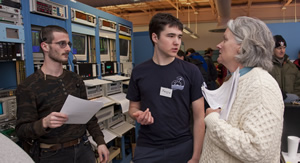Student rocket flies with success
Student rocket flies with success
Submitted by Amy Hartley
Phone: 907-474-5823
01/12/09

University of Alaska Fairbanks students watched eagerly as their rocket project launched successfully from Poker Flat Research Range on Saturday, Jan. 10, 2009. The Ionospheric Science and Inertial Sensing project, called ISIS for short, launched at 2:17 p.m. Alaska Standard Time and flew as designed to the D-region of the ionosphere. A NASA sounding rocket carried the experiment to an altitude of nearly 61 vertical miles.
Students, past and present, developed the instrumentation inside the payload of ISIS. The 147-pound payload was equipped with a plasma probe, radio receivers and more. The ISIS payload also included instrumentation to study the thinning of ultraviolet rays in the atmosphere. This aspect was in collaboration with Tokai University and the University of Toyama in Japan. Nine Japanese students and two faculty members traveled to Poker Flat Research Range to witness the launch of ISIS and to analyze information collected by the rocket.
The Alaska Student Rocket Project operates under the direction of principal investigator Denise Thorsen, Alaska Space Grant Program director, and Joe Hawkins, a UAF professor of electrical and computer engineering. Saturday’s launch was the fifth by the the project’s student researchers at Poker Flat since the early 1990s.
"One of the things this program does is it goes beyond the classroom. It develops leadership and it’s very holistic," Thorsen said. "Students develop professionalism and when they graduate, they can enter the job market and say, ’I’m ready to roll.’"
"[The ISIS launch] was a great example of the awesome opportunities available to engineering students at UAF," said project manager Tess Caswell, an undergraduate engineering student at UAF. "The entire experience was very exciting!"
The ISIS rocket may have launched, but it’s not the end of the project. Students will now begin to comb through all the data collected Jan. 10. Thorsen said the initial data looks promising, so students will be busy over the next few months. One student from the ISIS team will use data collected by the rocket to recreate the launch in a three-dimensional visualization that the team will study in the future.
Meanwhile, Thorsen and Hawkins look to broaden the opportunities for students in the Alaska Student Rocket Project. The two professors say work on small spacecraft payloads and experiences with satellite missions are attractive options for the future.
The next rocket on the launch schedule at Poker Flat Research Range is Auroral Current and Electrodynamics Structure, or ACES. It will include two separate vehicles that will fly through different sections of an auroral arc. Scott Bounds from the Department of Physics and Astronomy at the University of Iowa is the principal investigator for the project.
Poker Flat Research Range is the largest land-based sounding rocket range in the world. It’s located 30 miles north of Fairbanks on the Steese Highway. The Geophysical Institute at UAF operates the range under contract to NASA.
CONTACT: Alaska Space Grant Program director Denise Thorsen at 907-474-7052 or ffdt@uaf.edu. Professor of electrical and computer engineering Joe Hawkins at 907-474-5206 or ffjgh@uaf.edu Geophysical Institute information officer Amy Hartley at 907-474-5823 or amy.hartley@gi.alaska.edu
ON THE WEB:
www.uaf.edu/asgp/asrp/srp.htm
www.gi.alaska.edu/pfrr


